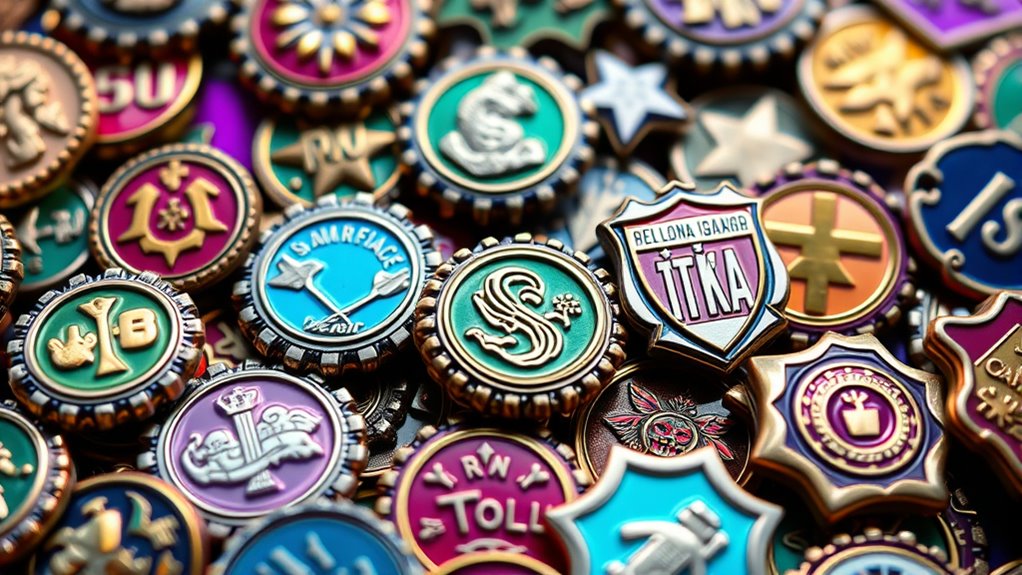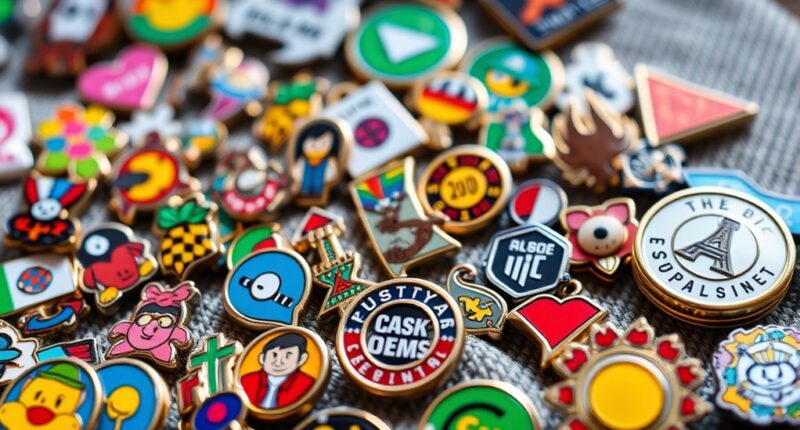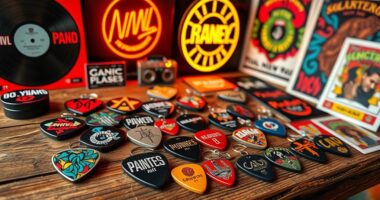Trading pins and enamel badges are tiny collectibles packed with history, vibrant designs, and personal meaning, making them more than just souvenirs. They reflect your identity, commemorate special moments, or connect you with a community of enthusiasts. From intricate details to bold symbols, each badge has a story to tell. If you want to discover how these small objects carry big significance and cultural value, keep exploring their fascinating world.
Key Takeaways
- Trading pins and enamel badges are popular collectibles that symbolize identity, achievements, and community connections across various groups and events.
- Their unique designs often incorporate vibrant graphics and detailed craftsmanship, making each piece meaningful and visually appealing.
- These small collectibles have a rich history, evolving from military insignia to symbols of organization membership and personal milestones.
- Collecting and trading pins fosters a vibrant community, connecting enthusiasts through shared interests and appreciation of craftsmanship.
- Their cultural significance and nostalgic value increase their desirability, turning simple items into meaningful pieces of history and culture.

Trading pins and enamel badges have become popular collectibles among enthusiasts of all ages, offering a fun way to commemorate events, organizations, or personal achievements. When you start exploring these small treasures, you’ll quickly notice how much thought and creativity go into their design. Each pin’s design reflects its purpose, whether it’s a souvenir from a sports team, a badge from a scouting event, or a commemorative item for a special occasion. The art of pin design is a fascinating aspect because it combines graphic elements, colors, and shapes that tell a story or evoke a memory. Some pins feature intricate details, while others are simple but bold, making each piece unique and meaningful to its wearer or collector. As you collect, you’ll find that pin design plays a pivotal role in how these badges are perceived and valued, often making them more than just accessories—they become symbols of identity and camaraderie. Understanding badge history adds depth to your appreciation. The origins of enamel badges date back centuries, initially used for military identification, ranks, or membership symbols. Over time, their purpose expanded into civilian use, especially in organizations like Boy Scouts, Girl Scouts, and various clubs. These badges served as tangible proof of achievement or affiliation, fostering pride and motivation. Today, enamel badges have evolved from their traditional roots into vibrant collectibles, often customized for specific events or groups. Their rich badge history influences how they are crafted and valued, connecting modern collectors with a longstanding tradition of symbolism and recognition. This history also explains why some badges boast vintage appeal and why certain designs are more sought after. When you choose a pin or badge to add to your collection, you’re not just acquiring a small object—you’re holding a piece of history and culture. The craftsmanship involved, from the initial design to the finishing touches, makes each badge special. Many manufacturers pay homage to badge history by incorporating classic motifs or traditional techniques into their designs. Whether you’re drawn to a retro style or a modern, sleek look, understanding the evolution of pin design and badge history enriches your experience. It helps you appreciate the effort behind each piece and the stories they carry. As you trade and collect, you become part of a vibrant community that values these small but impactful collectibles, connecting past and present through colorful, meaningful designs. Understanding badge history enhances your ability to recognize quality and significance in each piece.
Frequently Asked Questions
How Do I Determine the Value of a Collectible Pin or Badge?
To determine the value of a collectible pin or badge, start by researching current market trends to see what similar items are selling for. Use reliable pricing guides to get a ballpark estimate, but also check recent sales on online marketplaces. Consider the item’s condition, rarity, and any unique features, as these can considerably influence its worth. Combining these factors helps you set an accurate and fair value.
What Materials Are Commonly Used in High-Quality Pins and Badges?
Think of high-quality pins and badges as tiny works of art. They often use durable metal alloys like brass, copper, or iron for strength and a polished look. Enamel types, such as soft or hard enamel, add vibrant colors and smooth surfaces. These materials combine to create collectibles that are both visually appealing and long-lasting, making your pins stand out in any collection.
How Can I Ensure My Pins and Badges Are Authentic?
To guarantee your pins and badges are authentic, use authentication tips like examining the quality of the materials and craftsmanship. Look for clear, consistent engravings and check for official markings or logos. Be cautious of counterfeit detection signs like poor finish or flimsy backing. Purchase from reputable sellers or authorized dealers, and compare items with verified authentic pieces. Doing this helps protect your collection and guarantees you’re getting genuine collectibles.
Are There Specific Care Instructions to Preserve Their Condition?
To safeguard your pins and badges, follow proper cleaning techniques by gently wiping them with a soft, damp cloth and avoiding harsh chemicals. Store them in a protective case or display box to prevent scratches and tarnishing. Keep them in a cool, dry place away from direct sunlight. Proper care ensures your collectibles stay vibrant and in excellent condition for years to come, making your collection even more valuable.
Where Can I Find Rare or Limited-Edition Collectible Pins?
A treasure hunt often leads you to rare or limited-edition collectible pins; start by exploring collector communities and online marketplaces. These platforms are treasure troves for unique finds, where enthusiasts share tips and trade. Remember, “fortune favors the bold,” so don’t hesitate to reach out and ask questions. With patience and persistence, you’ll uncover those elusive pins that add sparkle to your collection.
Conclusion
Trading pins and enamel badges may seem like simple collectibles, but they hold real meaning and connections. Don’t dismiss them as just trinkets; they create memories, foster friendships, and celebrate shared passions. Even if you’re worried about the cost or effort, the joy of trading and the stories behind each piece make it worth it. Embrace these small treasures—they’re more than just collectibles; they’re gateways to lasting experiences.









